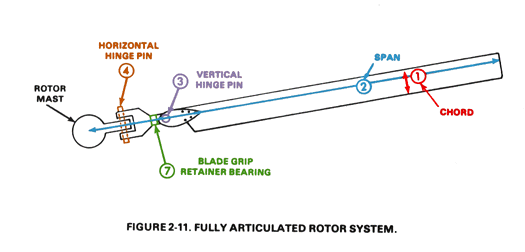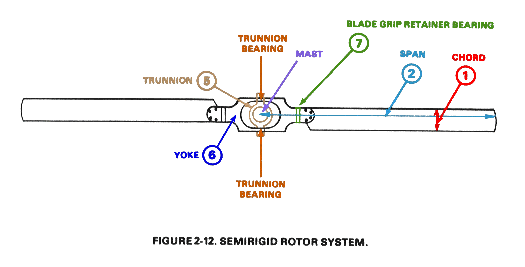[Top]
[Up]
[Prev]
[Next]
Rotary Wing Planform
Common terms used to describe the helicopter rotor system are shown here.
Although there is some variation in systems between different aircraft,
the terms shown are generally accepted by most manufacturers. The system
shown here is fully articulated:

Semirigid types do not have a vertical or horizontal hinge pin. Instead,
the rotor is allowed to teeter or flap by a trunnion bearing that connects
the yoke to the mast:

- The chordis the longitudinal dimension of an airfoil
section, measured from the leading edge to the trailing edge.
- The span is the length of the rotor blade from the
point of rotation to the tip of the blade.
- The vertical hinge pin (drag hinge) is the axis which
permits fore and aft blade movement independent of the other
blades in the system.
- The horizontal hinge pin is the axis which permits up
and down movement of the blade independent of the other
blades in the system.
- The trunnion is splined to the mast and has two
bearings through which it is secured to the yoke. The blades
are mounted to the yoke and are free to teeter (flap) around
the trunnion bearings.
- The yoke is the structural member to which the blades
are attached and which fastens the rotor blades to the mast
through the trunnion and trunnion bearings.
- The blade grip retainer bearing is the bearing which
permits rotation of the blade about its spanwise axis so blade
pitch can be changed (blade feathering)
- Blade Twist is a characteristic built into the rotor
blade so angle of incidence is less near the tip than at the
root. Blade twist helps distribute the lift evenly along the
blade by an increased angle of incidence near the root where
blade speed is slower. Outboard portions of the blade that
travel faster normally have lower angles of incidence, so
less lift is concentrated near the blade tip.
Paul Cantrell
paul at copters.com
(replace " at " with "@" to email me - this avoids SPAMMERS I hope)
[Top]
[Up]
[Prev]
[Next]


